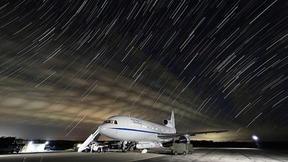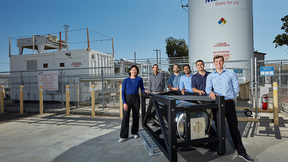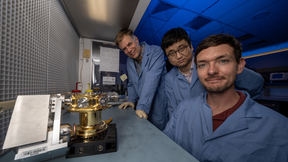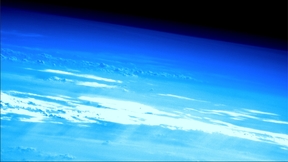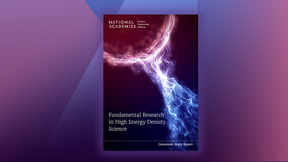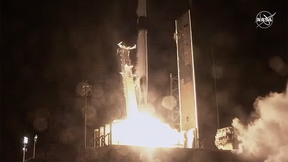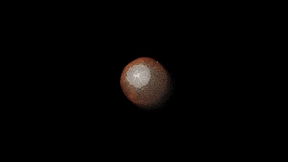Back
Global Security
Big Ideas Lab takes a closer look at NARAC
It’s been 45 years since the first emergency phone call from the Department of Energy came into Lawrence Livermore National Laboratory (LLNL) to activate a new atmospheric modeling center that predicts the effects of hazardous plumes. Listen on Apple or Spotify. An accident had occurred at the Three Mile Island nuclear power plant in Pennsylvania on March 28, 1979, that…
LLNL's Buddemeier named to National Academies board
Lawrence Livermore National Laboratory (LLNL) certified health physicist Brooke Buddemeier has been appointed to a panel of the National Academies of Sciences, Engineering and Medicine. A 35-year Lab employee, Buddemeier has been named to the Nuclear and Radiation Studies Board (NRSB), which provides advice about safety, security, technical efficacy and other issues…
Americans increase overall pace of decarbonization, but state trends vary
In 2023, Americans reduced their consumption of electricity and fossil fuels, while increasing consumption of carbon-free energies, according to the most recent energy and carbon flowcharts released by Lawrence Livermore National Laboratory (LLNL). Each year, LLNL releases these flowcharts to illustrate the nation's consumption and uses of energy, as well as associated CO2…
All ears on the Big Ideas Lab podcast
Lawrence Livermore National Laboratory (LLNL) has big ideas and is showing the world in the Big Ideas Lab weekly podcast that takes listeners behind the fences and into its heart. “This is where big ideas come to life,” said Lab Director Kim Budil. “To do this, we bring together dynamic teams of many different disciplines — laser physicists and materials scientists and…
Deep Purple payload successfully deployed and operational
The Deep Purple telescope developed by Lawrence Livermore National Laboratory (LLNL) researchers is now operational in space. The Livermore instrument, which utilizes a new design for an ultra-violet (UV) and short-wave infrared monolithic telescope features a novel, compact optical system and electronics package inside a lightweight, modular housing. On Friday, Aug. 16,…
Lab team surveys Site 300 for hotspots
In the mid-afternoon of Saturday, June 1, the Corral Fire ignited near the Lab’s Site 300. It made headlines for days and kicked off this year’s fire season. The blaze raced across more than 14,000 acres in just 24 hours, incinerated a structure and badly burned two fire personnel. Early Sunday morning, the Lab’s Associate Principal Deputy Director Sandra Brereton reached…
LLNL delivers compact dual-band telescope for launch this summer
Lawrence Livermore National Laboratory’s (LLNL) space hardware team has delivered a payload for NASA’s Pathfinder Technology Demonstrator-R (PTD-R) satellite. LLNL developed the optical payload, called Deep Purple, that utilizes a new design for an ultra-violet (UV) and short-wave infrared (SWIR) monolithic telescope. The mission will demonstrate simultaneous monolithic UV…
LLNL gamma-ray sensor has the best resolution
It’s official. An instrument designed and built by Lawrence Livermore National Laboratory (LLNL) researchers is the highest-resolution gamma ray sensor that has ever flown in space. The Livermore high-purity germanium (HPGe) gamma ray sensor is an essential part of a larger gamma-ray spectrometer (GRS) built in collaboration with researchers from Johns Hopkins Applied…
Signal and image science community comes together for annual workshop
Nearly 150 members of the signal and image science community recently came together to discuss the latest advances in the field and connect with colleagues, friends and potential collaborators at the 28th annual Center for Advanced Image and Signal Science (CASIS) workshop. Held at the University of California Livermore Collaboration Center (UCLCC) for the first time, the…
FAA awards first approval for drone swarm testing
Lawrence Livermore National Laboratory’s (LLNL) Autonomous Sensors team has received the Federal Aviation Administration’s (FAA’s) first and — to date — only certificate of authorization (COA) allowing autonomous drone swarming exercises on the Lab main campus. These flights will test swarm controls and sensor payloads used in a variety of national security applications…
Lab to provide optical payload for upcoming U.S. Space Force mission
Lawrence Livermore National Laboratory’s (LLNL) Space Program is now building an optical space domain awareness payload for an upcoming mission by the U.S. Space Force. The planned mission, known as VICTUS HAZE, will be a tactically responsive space mission to demonstrate the ability to rapidly characterize an on-orbit threat. The U.S. Space Force selected Long Beach,…
LLNL Pandora SmallSat mission clears major NASA milestone on the path toward launch
Lawrence Livermore National Laboratory’s (LLNL) Pandora SmallSat mission recently passed NASA’s critical design review: a major milestone for the mission to continue its journey toward launch. The Pandora SmallSat mission will study planets beyond our solar system, known as exoplanets, and their stars. “This is a major milestone for the mission and a huge accomplishment…
Hydrogen storage demonstrated for semi trucks
Lawrence Livermore National Laboratory (LLNL) and Verne, a San Francisco-based startup, have demonstrated a cryo-compressed hydrogen storage system of suitable scale for heavy-duty vehicles. This is the first time cryo-compressed hydrogen storage has been demonstrated at a scale large enough to be useful for semi trucks, a milestone in high-density hydrogen storage…
New analysis outlines national opportunities to remove CO2 at the gigaton scale
Lawrence Livermore National Laboratory (LLNL) researchers, along with scientists from more than a dozen institutions, have completed a first-of-its-kind high-resolution assessment of carbon dioxide (CO2) removal (CDR) in the United States. The report, “Roads to Removal: Options for Carbon Dioxide Removal in the United States,” charts a path for the United States to achieve…
Lab partners with new Space Force Lab
Lawrence Livermore National Laboratory subject matter experts (SMEs) have been selected by the United States Space Force to help stand up its newest Tools, Applications and Processing (TAP) laboratory dedicated to advancing military space domain awareness (SDA). The LLNL team attended the Oct. 26 kick-off in Colorado Springs of the SDA TAP lab’s Project Apollo technology…
Lab instrument now on two-billion-mile journey to the metallic asteroid Psyche
An instrument designed and built by Lawrence Livermore National Laboratory (LLNL) researchers departed Earth last week on a two-billion-mile, nearly six-year journey through space to explore a rare, largely metal asteroid. The Livermore high-purity germanium (HPGe) gamma-ray sensor is an essential part of a larger gamma-ray spectrometer (GRS) built in collaboration with…
LLNL’s prototype telescope now fully operational aboard the International Space Station
When SpaceX’s Dragon spacecraft docked with the International Space Station (ISS) on March 16, it delivered several thousand pounds of supplies for the crew as well as new hardware. The hardware included the U.S. Space Force’s Space Test Program Houston 9 (STP-H9) platform, which houses a prototype telescope designed and built by Lawrence Livermore National Laboratory's…
National Academies release report on high energy density science with LLNL contributions
The National Academies of Sciences, Engineering, and Medicine released a report, Fundamental Research in High Energy Density Science, which identifies key challenges and science questions for the field of High Energy Density (HED) science for the coming decade and proposes ways to address them. The report follows a year-and-a-half-long consensus study by a committee of 13…
Prototype telescope designed by LLNL researchers launched to the International Space Station
A prototype telescope designed and built by Lawrence Livermore National Laboratory (LLNL) researchers has been launched from Cape Canaveral, Fla., to the International Space Station (ISS). Known as the Stellar Occultation Hypertemporal Imaging Payload (SOHIP), the telescope uses LLNL patented-monolithic optics technology on a gimbal to observe and measure atmospheric…
High-fidelity simulation offers insight into 2013 Chelyabinsk meteor
On the morning of Feb. 15, 2013, a small asteroid exploded over Chelyabinsk, Russia, sending a loud shockwave and sonic boom across the region, damaging buildings and leaving around 1,200 people injured. The resulting meteor, with a diameter of approximate 20 meters (roughly the size of a six-story building), was one of the largest to be detected breaking up in the Earth’s…












